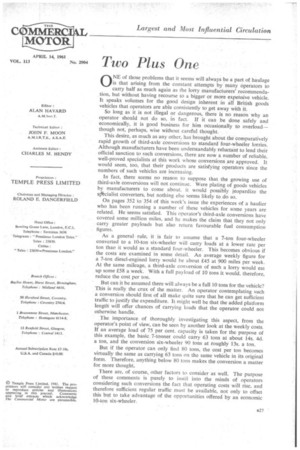Two Plus One
Page 35

If you've noticed an error in this article please click here to report it so we can fix it.
0 NE of those problems that it seems will always be a part of haulage is that arising from the constant attempts by many operators to carry half as much again as the lofty manufacturers' recommendation, but without having recourse to a bigger or more expensive vehicle. It speaks volumes for the good design inherent in all British goods vehicles that operators are able consistently to get away with it.
So long as it is not illegal or dangerous, there is no reason why an operator should not do so, in fact. If it can be done safely and economically, it is good business for him occasionally to overload— though not, perhaps, wise without careful thought.
This desire, as much as any other, has brought about the comparatively rapid growth of third-axle conversions to standard four-Wheeler lorries. Although manufacturers have been understandably reluctant to lend their official sanction to such conversions, there are now a number of reliable, well-proved specialists at this work whose conversions are approved. It would seem, too, that their products are satisfying operators since the numbers of such vehicles are increasing.
in fact, there seems no reason to suppose that the growing use of third-axle conversions will not continue. Were plating of goods vehicles by manufacturers to come about, it would possibly jeopardize the setcialist converters, but nothing else seems likely to do so.
On pages 352 to '354 of this week's issue the experiences of a haulier who has been running a number of these vehicles for some years are related. He seems satisfied. This operator's third-axle conversions have covered some million miles, and he makes the claim that they not only carry greater payloads but also return favourable fuel consumption figures.
As a general rule, it is fair to assume that a 7-ton four-wheeler converted to a 10-ton six-wheeler will carry loads at a lower rate per ton than it would as a standard four-wheeler. This becomes obvious if the costs are examined in some detail. An average weekly figure for a 7-ton diesel-engined lorry would be about £45 at 900 miles per week. At the same mileage, a third-axle conversion of such a lorry would eat up some £58 a week. With a full payload of 10 tons it would, therefore, reduce the cost per ton.
But can it be assumed there will always be a full 10 tons for the vehicle? This is really the crux of the matter. An operator contemplating such a conversion should first of all make quite sure that he can get sufficient traffic to justify the expenditure. It might well be that the added platform length will offer chances of carrying loads that the operator could not otherwise handle.
The importance of thoroughly investigating this aspect, from the operator's point of view, can be seen by another look at the weekly costs. If an average load of 75 per cent. capacity is taken for the purpose of this example, the basic 7-tonner could carry 63 tons at about 14s. 4d. a ton, and the conversion six-wheeler 90 tons at roughly 13s. a ton.
But if the operator can only find 80 tons, the cost per ton becomes virtually the same as carrying 63 tons on the same vehicle in its original form. Therefore, anything below 80 tons makes the conversion a matter for more thought, There are, of course, other factors to consider as well. The purpose of these comments is purely to instil into the minds of operators considering such conversions the fact that operating costs will rise, and therefore sufficient regular traffic must be available, not only to offset this but to take advantage of the opportunities offered by an economic 10-ton six-wheeler.
































































































































